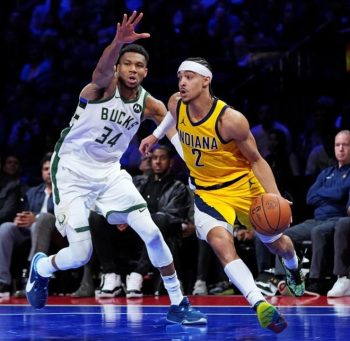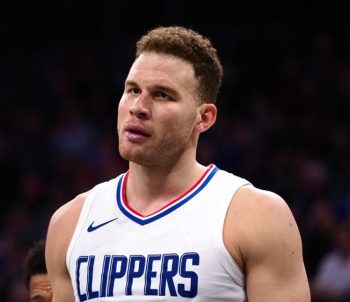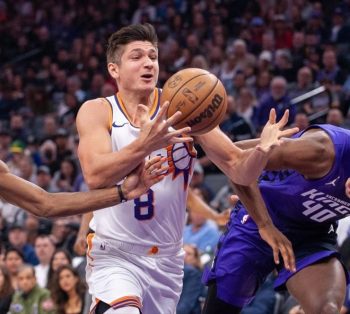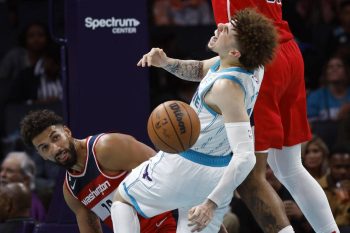NBA
Pro and Cons of Knicks’ Trade for Derrick Rose

We all knew the New York Knicks desperately needed to upgrade their backcourt this summer. Phil Jackson decided he’d rather not wait until free agency to address the point guard position.
On Thursday afternoon, the Knicks officially announced they had traded center Robin Lopez, guard Jose Calderon and guard Jerian Grant to Chicago in exchange for guard Derrick Rose, guard Justin Holiday and a 2017 second-round pick.
It’s an interesting and confusing trade, in which there does not appear to be a clear-cut winner – at least not at first blush. Let’s dig into the pros and cons from the Knicks’ perspective.
Pros:
Increased Cap Space in 2017
Before we discuss Rose, let’s first acknowledge that the Knicks currently have just three players on their roster whose contracts extend beyond the 2016-17 season: Carmelo Anthony, Kristaps Porzingis and Kyle O’Quinn. That’s it. Other than those three, the books are bare. Of course the Knicks still have to flesh out their roster this summer, but it’s possible that Phil Jackson may be planning on completely revamping the roster and swinging for the fences in the summer of 2017, which will feature an incredible free agent class including the best PG crop of all-time.
If the Knicks play their cards right (i.e. trade for additional expiring contracts and/or sign a number of players to one-year deals), New York would be looking at upwards of $60 million in cap space next summer. And that’s not just cap space and a barren, empty roster. That’s with the salaries of ‘Melo and Porzingis included, with another $60 million to lavish on top-tier free agents. That’s enough to offer two max contracts. Would Phil be able to entice the combo or Kevin Durant and Russell Westbrook to relocate into the Eastern Conference to play alongside a rising superstar like KP as well as Anthony? The free agent class of 2017 will also likely include Steph Curry, Blake Griffin, Chris Paul, Gordon Haywood, Paul Millsap, Kyle Lowry, Danilo Gallinari, Serge Ibaka and many others. Certainly a gamble, but is it one worth taking?
A Possible Rose Revival Inside the Garden?
Will Rose stay healthy and bounce back in NYC? Will a change of scenery benefit him?
Depending on how you dissect the data from last season, you can convince yourself either way. The fact of the matter is he was inefficient offensively. There were 40 NBA players who attempted over 1,000 FGs last season, and Rose ranked 39th out of those 40 in terms of True Shooting Percentage. Kobe Bryant was the only player with a worse TS%. However, Rose’s overall numbers were dragged down by his horrendous start to the season, which was due largely to an eye injury sustained in training camp. Rose had his orbital bone fractured by an errant elbow from a teammate in practice on September 29 and had surgery the next day. Rose admitted he was literally seeing double during games and would play with one eye closed at times.
Over his first 20 games of the 2015-16 campaign, Rose (playing through that eye injury) averaged 12.9 points per game in 32.4 minutes, while shooting under 37 percent from the floor, 23 percent from three-point territory and 72 percent on free throws.
However, Rose turned a corner and began playing much better in late December. Beginning on the day after Christmas and extending into mid-March (a total of 28 games in the middle of the season), he averaged 19.4 points per game in 31.4 minutes, while shooting 46.9 percent from the floor, 35.5 percent from three-point range and 87 percent from the free-throw line. Those are impressive numbers.
Rose came back down to earth toward the end of the season. He missed six of the final 19 games of the year. In the 13 that he played, he averaged a respectable 15 points while shooting 42.8 percent, 31 percent on threes and 70 percent from the stripe. Rose’s on/off splits last season weren’t encouraging: Chcicago’s Offensive Rating with him on the court was 104.6; it was 105.2 with him off.
His defense is an issue. Chicago’s opponents scored 108.5 points per 100 possessions with Rose on the floor. They scored 104.4 points per 100 possessions with Rose on the bench
Still, Rose was able to avoid a serious injury to his knees and look fresher and more athletic at times that he had in years. Rose will never be his “MVP-caliber” self of 2011, but he showed encouraging flashes of the burst and athleticism that thrust him to stardom.
Knicks Desperately Needed to Improve at PG
The sad reality is that if Rose plays at even an average level next season, he would be a huge upgrade for the Knicks. Jose Calderon was arguably the NBA’s worst starting point last year. In order to be competitive in today’s NBA, it is imperative that you have a point guard who can break down his defender and penetrate into the heart of the defense, thus creating opportunities for himself and his teammates.
Calderon scored a total of 46 points in the paint over the 2,024 total minutes he played last season. Rose scored 453 points in the paint (10th most in the league) over the 2,097 minutes he played. And even though his defense leaves a lot to be desired, Rose is obviously still a massive upgrade over Calderon on that end of the floor as well.
It is also important to note that there were very few attractive free agents PGs on the market this summer. Mike Conley is the only top-tier PG available, and he is going to get max money. Rose, while no longer as good as Conley, is a year younger and actually played in 10 more games last season than Conley (who suffered a significant Achilles injury). It could easily be argued that one year of Rose is a far more prudent decision than spending $110 million over four years for Conley.
The Knicks now get an up-close look at Rose for an entire season, and can then decide if they want to sign him to be Porzingis’ running mate for the rest of the decade. If not, they will have $21+ million coming off the books to go shopping for a new PG.
A Playoff Team in 2017?
If the goal is to revamp the roster next summer, it would presumably benefit Phil Jackson’s sales pitch if the Knicks are coming off a season in which they showed tangible improvement and advanced to the postseason.
Even with oodles of cap space and the promise of Porzingis, if the Knicks entered next offseason having missed the playoffs in four consecutive seasons, that losing stench may be hard for prospective free agents to ignore. If New York can make strides in 2016-17, elite FAs may be sold on the idea that the Knicks are just one or two pieces away from making a major jump.
More Porzingis at Center?
Losing Robin Lopez hurts, but one possible bright side of Lopez being out of the picture is that this might lead to increased opportunities for Kristaps to play the five, where he can use his incredible athleticism and versatility to overwhelm slower opponents. Spread the floor out and let KP run high pick-and-rolls with Rose all day.
You also can’t help but wonder if part of the reason Phil and company felt comfortable trading away Lopez was because they feel confident they will be able to sign center Willy Hernangomez, their 2015 second-round pick who played well in Spain last season. Hernangomez’s contract with Real Madrid expires at the end of this month and he expressed an eagerness to come overseas and play in New York, alongside his former teammate Porzingis. (*Note, if the Knicks do something stupid like sign Dwight Howard to a big contract then the previous paragraph will self destruct and this was all was naught).
The Knicks Have Their 2017 First-Round Draft Pick
The worst case scenario is Rose suffering a major injury and the Knicks slinking to another season in the Atlantic Division basement. However, even in that situation, the silver lining is the Knicks still have their first-round pick next year. They would shed Rose’s contract prior to free agency and have a lottery pick in a strong draft.
Cons:
Why Give Away Valuable Assets For Rose?
When Ian Begley of ESPN initially reported that the Knicks were entertaining the idea of trading for Rose last week, it made some sense for the points outlined above. Rose would keep ‘Melo, James Dolan and the fan base happy by improving the team’s prospects for next season, while also serving as a salary cap placeholder until 2017. In fact, many pundits reported that most other teams dealing with the Bulls demanded that Chicago throw in a pick or another player in order to take on Rose’s cumbersome contract.
Not only did Chicago not have to sweeten the Rose package with a first-round pick, they got Phil to fork over Lopez and Grant. Lopez was an underrated defensive stalwart for New York, and Grant, despite being unwisely buried on the bench for much of the season, showed flashes of promise late in the year. In the six games he started at the end of the season, Grant averaged 14.5 points, 3.7 assists, 3.7 rebounds, 1.2 three-pointers and 1.2 steals per game, while shooting 49.3 percent from the floor and 36.8 percent from three-point territory. It also would have been interesting to see if he flourished under new head coach Jeff Hornacek in an offense more suited to his strengths.
Lopez and Grant Are Inexpensive
Robin Lopez certainly wasn’t a star, and $13 million a year doesn’t seem cheap. However, check back with me in a couple weeks, right after the first few waves of free agents have signed throughout July. With the salary cap spiking to $94 million, that means that the salary floor will jump all the way to $84 million. Consequently, every team is going to have to find a way to hand out an immense amount of salary this summer. Relatively unappealing mid-tier free agents will be making upwards of $15 million per season. And $13 million for a legit starting center will be a solid value.
Players signed to their rookie contracts will also be especially valuable. Jerian Grant will only make $1.6 million next season. He’ll be paid just $1.7 million in 2017-18. That’s less than two percent of the salary cap. Grant likely projects as an average career backup, but having dependable rotation players that account for such a small percentage of the cap is how winning teams are constructed.
Defense Is Now a Major Issue
The Knicks allowed fewer than 108 points per 100 possessions last season. That’s below average relative to the rest of the league, but for the Knicks that represented a major step forward. In fact, it was just the third time in the last 12 years that the Knicks had a Defensive Rating south of 108.
Lopez was obviously a significant reason for their improved defensive intensity. Lopez led the Knicks in rebounding and was second on the team in blocks. Phil has $30 million to spend this summer to round out the roster, but with Rose and Carmelo as the team’s two highest paid players, defense certainly appears as if it will be a season-long problem.
Downside to Cap Space and a Rose Rebound
The negative aspect of Rose hitting free agency next summer is that even if he stays healthy and rediscovers his game, the Knicks will have to pony up in order to keep him long-term, which would obviously be a major gamble.
In addition, with the cap space the Knicks cleared out by trading Lopez and Grant, will Phil be able to better allocate those resources? Will he find a better use of $15 million combined than RoLo and Grant? If he can somehow convince a superstar to come to New York, then the roll of the dice pays off. If he can’t, it’s difficult to imagine he’ll find a better value for role players with the cap jumping up to $108 million in 2017.
As is the case with most deals, we will likely have to revisit the entire picture a few years from now to truthfully determine which side “won” or “lost” this trade.











